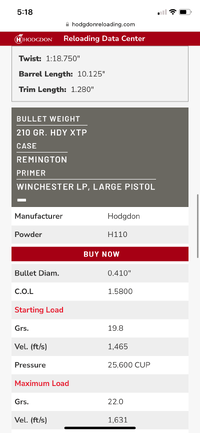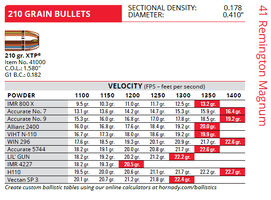Before I dive back into my bottle of H-110 I thought I would bounce a couple things off of those more experienced reloaders. I was rereading a couple chapters in "The ABCs of Reloading" the other night when a paragraph in the reduced loads section made me stop and read it again, and again. It states "an underloaded cartridge can generate a pressure spike that is just as dangerous as an overloaded cartridge." The author goes on to talk about a 300 Win Mag rifle that was unbearable with a particular starting load, and only settled down as the charge increased. I started to wonder if this is what happened to me a few weeks ago with my very first true magnum loads for the .41 Rem Mag.
I subscribe to LoadData.com and found data put out by Montana Bullet Co for a 215gr cast SWC and 21 grains of H-110. Unlike any other powders on the page there was no starting load, just the maximum with a note below in bold letters to "never reduce by more than 3%." Even with my math skills I was able to determine my starting load was 20.4 grains. I loaded 6 rounds and continued with a half a dozen at 20.6, 20.8 and 21 gr with a similar cast Rushmore 215gr SWC. A few days later off to the range.
All my trials of new loads until then had been at 50yds, but they were slower special rounds so that day I opted for 25yds, thinking it might be easier to get holes into the paper. I hung an 18" square target on the backer, loaded a round, rested on the bean bag and pressed the trigger......... what happened next was the second worst experience I have ever had with a firearm, I did have a shotgun blow up on the trap range on morning. There was flash, smoke, a lotta noise and even more recoil--- well beyond anything that could be considered normal. I inspected the case and primer. Nothing seemed out of place. I decided to try again. Same thing. This case too looked OK, but neither round had hit paper, or even the cardboard backer. getting stubborn I fired the last 4 starting loads and never once touched the target. Pissed, I packed up for another day.
So here I am. I have looked at loads for various other 210 and 220 gr bullets and starting loads run in the 19 - 21 gr range. I have considered my Federal GM primers vs their WLPs or my unfired starline brass vs their Winchester. LOA? Too much space in the case? Any?
Thanx
I subscribe to LoadData.com and found data put out by Montana Bullet Co for a 215gr cast SWC and 21 grains of H-110. Unlike any other powders on the page there was no starting load, just the maximum with a note below in bold letters to "never reduce by more than 3%." Even with my math skills I was able to determine my starting load was 20.4 grains. I loaded 6 rounds and continued with a half a dozen at 20.6, 20.8 and 21 gr with a similar cast Rushmore 215gr SWC. A few days later off to the range.
All my trials of new loads until then had been at 50yds, but they were slower special rounds so that day I opted for 25yds, thinking it might be easier to get holes into the paper. I hung an 18" square target on the backer, loaded a round, rested on the bean bag and pressed the trigger......... what happened next was the second worst experience I have ever had with a firearm, I did have a shotgun blow up on the trap range on morning. There was flash, smoke, a lotta noise and even more recoil--- well beyond anything that could be considered normal. I inspected the case and primer. Nothing seemed out of place. I decided to try again. Same thing. This case too looked OK, but neither round had hit paper, or even the cardboard backer. getting stubborn I fired the last 4 starting loads and never once touched the target. Pissed, I packed up for another day.
So here I am. I have looked at loads for various other 210 and 220 gr bullets and starting loads run in the 19 - 21 gr range. I have considered my Federal GM primers vs their WLPs or my unfired starline brass vs their Winchester. LOA? Too much space in the case? Any?
Thanx


